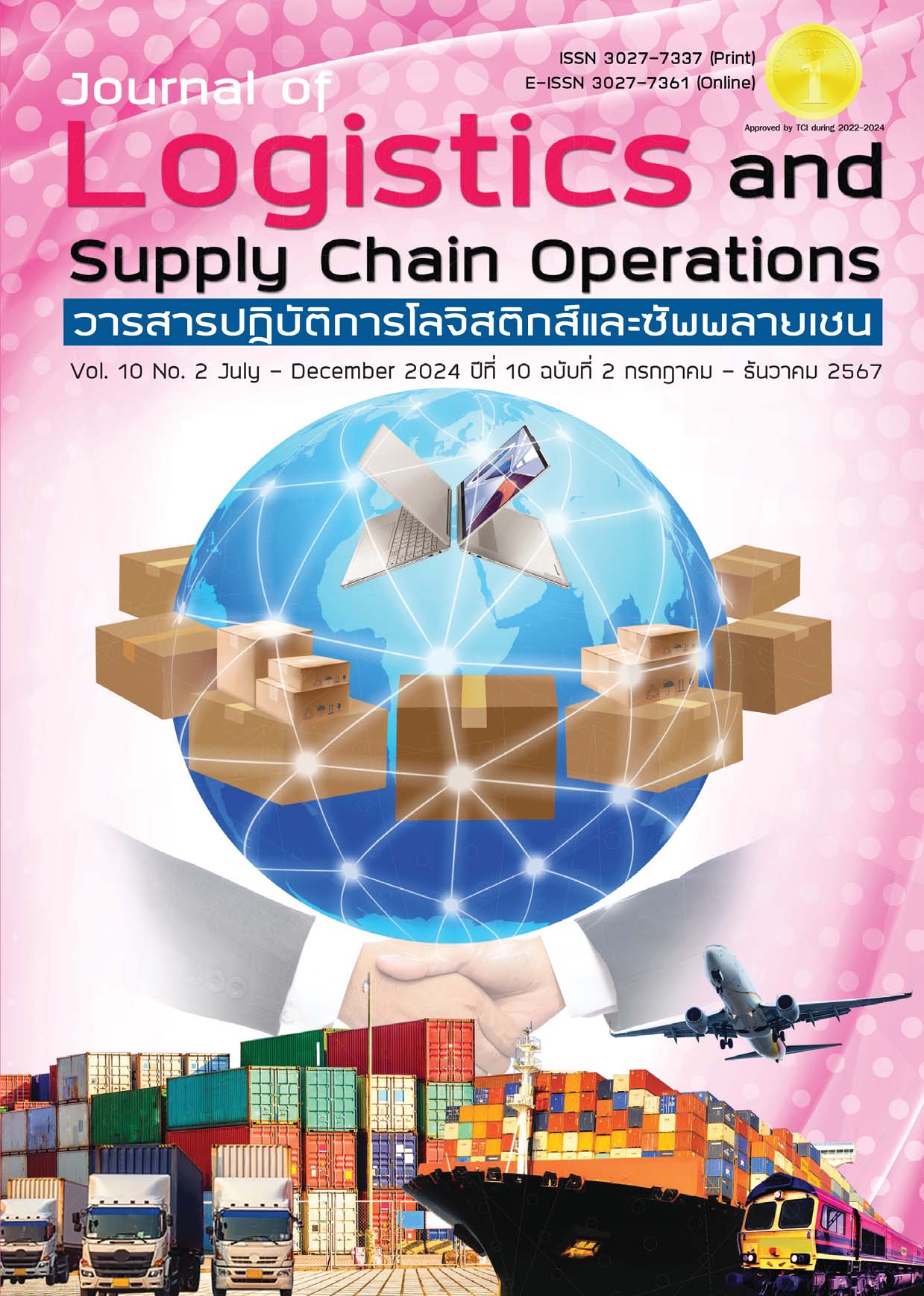การจัดการโซ่อุปทานของผักปลอดภัยด้วยตัวแบบ SCOR: กรณีศึกษากลุ่มเกษตรแปลงใหญ่ อำเภอหล่มสัก จังหวัดเพชรบูรณ์
DOI:
https://doi.org/10.53848/jlsco.v10i2.268498คำสำคัญ:
การจัดการโซ่อุปทาน , ตัวแบบSCOR ผักปลอดภัย , ต้นน้ำ-กลางน้ำ-ปลายน้ำบทคัดย่อ
งานวิจัยนี้ มีวัตถุประสงค์เพื่อ 1) วิเคราะห์โซ่อุปทานผักปลอดภัยของกลุ่มเกษตรแปลงใหญ่ในอำเภอหล่มสัก จังหวัดเพชรบูรณ์ ด้วยตัวแบบ SCOR และ 2) ศึกษาปัญหาในโซ่อุปทานการผลิตผักปลอดภัยของกลุ่มเกษตรแปลงใหญ่ในอำเภอหล่มสัก จังหวัดเพชรบูรณ์ ใช้รูปแบบการวิจัยเชิงคุณภาพ ผู้ให้ข้อมูลการวิจัย คือ เกษตรกรของกลุ่มเกษตรแปลงใหญ่ที่ผ่านการรับรองมาตรฐานเกษตรปลอดภัย (GAP) ในอำเภอหล่มสัก จังหวัดเพชรบูรณ์ จำนวน 36 ราย เครื่องมือการวิจัยใช้แบบสัมภาษณ์ชนิดมีโครงสร้าง เก็บข้อมูลจากการสัมภาษณ์แบบเจาะลึก การสนทนากลุ่ม และการสังเกตแบบไม่มีส่วนร่วม วิเคราะห์ข้อมูลเชิงพรรณนา แสดงผลประกอบคำอธิบาย ผลการวิจัยพบว่า 1) รูปแบบโซ่อุปทานผักปลอดภัยของกลุ่มเกษตรแปลงใหญ่ อำเภอหล่มสักจังหวัดเพชรบูรณ์ ระดับต้นน้ำ ด้านการวางแผน มีการวางแผนการผลิต แผนขนส่ง และแผนรับคืนด้านการจัดหาปัจจัยการผลิต ใช้การจัดหาแบบกระจายอำนาจที่จัดซื้อผ่านคนกลาง ระดับกลางน้ำ ด้านการผลิตกลุ่มเกษตรกรที่มีบริษัทคู่ค้า ใช้รูปแบบการผลิตแบบผลิตตามคำสั่งซื้อ กลุ่มเกษตรกรที่ไม่มีบริษัทคู่ค้า ใช้รูปแบบการผลิตเพื่อจัดเก็บรอจำหน่าย ด้านการส่งมอบ กลุ่มเกษตรกรที่มีบริษัทคู่ค้า มีการกำหนดวันส่งมอบล่วงหน้า กำหนดระยะเวลารอคอยหลังคำสั่งซื้อ ปริมาณส่งมอบต่อเที่ยว ตารางส่งมอบ เส้นทางและพาหนะขนส่ง ระยะเวลาขนส่งต่อเที่ยว ซึ่งกลุ่มเกษตรกรที่ไม่มีบริษัทคู่ค้าไม่ได้ดำเนินการ ระดับปลายน้ำ พบว่า จุดหมายปลายทางของผักปลอดภัย มี 4 แหล่ง ได้แก่ ตลาดในชุมชนท้องถิ่น ตลาดค้าส่งในอำเภอ ตลาดค้าส่งขนาดใหญ่ระดับประเทศ และบริษัทคู่ค้าเพื่อจำหน่ายต่อให้ผู้บริโภคทั้งในประเทศและต่างประเทศ ด้านการส่งคืนเฉพาะกลุ่มเกษตรกรที่มีบริษัทคู่ค้ามีการบันทึกข้อมูลการรับคืน และด้านการสนับสนุนการดำเนินงาน พบว่า กลุ่มเกษตรกรมีการจัดเตรียมทรัพยากรและข้อมูลเพื่อสนับสนุนการดำเนินงานในกระบวนการวางแผน2) ปัญหาในโซ่อุปทานที่สำคัญคือกระบวนการส่งคืน โดยพบว่า กลุ่มเกษตรกรไม่สามารถตรวจสอบย้อนกลับเพื่อหาผู้ผลิตในระดับบุคคล แก้ไขโดยการพัฒนาระบบตรวจสอบย้อนกลับด้วยเทคโนโลยี QR Code ภายใต้งานวิจัย
เอกสารอ้างอิง
กฤตพา แสนชัยธร. (2564). กลยุทธ์การจัดการโซ่อุปทาน. พิมพ์ครั้งที่ 3. ขอนแก่น: โรงพิมพ์มหาวิทยาลัยขอนแก่น.
ณัฐจนันท์ รัตนมหาไพศาล. (2564). การวิเคราะห์โซ่คุณค่าของการปลูกสับปะรดในอำเภอแกลง จังหวัดระยอง. วิทยานิพนธ์ปริญญามหาบัณฑิต สาขาวิชาการจัดการโลจิสติกส์และโซ่อุปทาน, มหาวิทยาลัยบูรพา.
ณัฐพล บัวเปลี่ยนสี, ปรีดาพร อารักษ์สมบูรณ์, บุญชาติ คติวัฒน์ และวันเพ็ญ กลับกลาย. (2561). การจัดการห่วงโซ่อุปทานของสินค้าผักเบอร์ 8 เพื่อยกระดับศักยภาพของกลุ่มเกษตรกรในอำเภอพนมสารคาม จังหวัดฉะเชิงเทรา. วารสารวิชาการ มหาวิทยาลัยหอการค้าไทย มนุษยศาสตร์และสังคมศาสตร์, 38(4), 52-65.
ธงชัย วัชนุชา. (2564). ปัจจัยแห่งความสำเร็จของห่วงโซ่อุปทานธุรกิจการค้าผลไม้ไทย. วิทยานิพนธ์ปริญญาดุษฎีบัณฑิต สาขาวิชาบริหารธุรกิจ, มหาวิทยาลัยธุรกิจบัณฑิต.
นพพร ตันติศิริทร์. (2563). เศรษฐกิจการเกษตรกับประเทศไทย. ค้นเมื่อ 1 กุมภาพันธ์ 2565, จาก: http:// www.agri.ubu.ac.th/mis/evaluate/assess_learn/upload/95063.pdf.
นัทธพงศ์ นันทสำเริง, ปวิณญดา บุญรมย์, ธนวัฒน์ ศรีโยหะ, กฤติภรณ์ สุพร, เขมิกา มั่นคง และนิลวรรณ ชะลูด. (2565). แนวทางการปรับปรุงซัพพลายเชนของพริกขี้หนูอำเภอม่วงสามสิบ จังหวัดอุบลราชธานี. วารสารวิทยาลัยโลจิสติกส์และซัพพลายเชน, 8(1), 49-61.
นันทพันธ์ จิระเดชประไพ. (2560). การศึกษาความพร้อมในการจัดการโซ่อุปทานผักของอำเภอหล่มสัก จังหวัดเพชรบูรณ์. วารสารราชนครินทร์, 99(104), 99-104.
ประจวบ กล่อมจิตร. (2565). โลจิสติกส์-โซ่อุปทาน: การออกแบบและจัดการเบื้องต้น. กรุงเทพฯ: ซีเอ็ดยูเคชั่น.
เพ็ญพล สังข์แก้ว และถนัด แก้วเจริญไพศาล. (2561). การศึกษาการจัดการห่วงโซ่คุณค่าไม้ผล อำเภอเขาค้อ จังหวัดเพชรบูรณ์. วารสารวิจัยรามคำแหง (มนุษยศาสตร์และสังคมศาสตร์), 21(2), 24-35.
มงคล พัชรดำรงกุล. (2565). เป้าหมาย 7 ด้าน กระบวนการ 7 อย่าง ของ Supply chain. ค้นเมื่อ 1 กุมภาพันธ์ 2566, จาก: https://naitakeab.wordpress.com.
มลฑา สมบุญตนนท์, เออวดี เปรมัษเฐียร และกาญจนา ศรีพฤทธิ์เกียรติ. (2562). การดำเนินงานและส่วนเหลื่อมทางการตลาดของห่วงโซ่อุปทานผักไฮโดรโปนิกส์. วารสารปัญญาภิวัฒน์, 11(2), 147-161.
ศูนย์วิจัยและพัฒนาการเกษตรเพชรบูรณ์. (2565). รายชื่อเกษตรกร ได้รับรองมาตรฐาน GAP อำเภอหล่มสัก. ค้นเมื่อ 1 กุมภาพันธ์ 2565, จาก: https://www.doa.go.th/ac/phetchabun.
สำนักส่งเสริมวิสาหกิจขนาดกลางและขนาดย่อม. (2562). รายงานฉบับสมบูรณ์งานจัดทำยุทธศาสตร์และแผนปฏิบัติการส่งเสริม วิสาหกิจขนาดกลางและขนาดย่อมในอุตสาหกรรมการเกษตร. ค้นเมื่อ 1 กุมภาพันธ์ 2565, จาก: https://www.sme.go.th/upload/mod_download/download-20191022060242.pdf.
APICS. (2017). SCOR Supply chain operation reference model Version 12.0. Chicago: APICS.
Assarroudi, A., Nabavi, F. H., Armat, M. R., Ebadi, A., & Vaismoradi, M. (2018). Directed qualitative content analysis: The description and elaboration of its underpinning methods and data analysis process. Journal of Research in Nursing, 23(1), 42-55.
Crandall, R. E., Crandall, W. R., & Chen, C. C. (2015). Principles of supply chain management. 2nd ed. New York: CRC Press.
CSCMP. (2010). SCM definitions and glossary of terms. Retrieved 14 January 2023, From: https://cscmp.org/CSCMP/Educate/SCM_Definitions_and_Glossary_of_Terms.aspx.
Jones, T. C., & Riley, D. W. (1985). Using inventory for competitive advantage through supply chain management. International Journal of Physical Distribution and Materials Management, 15(1), 16-26.
Miles, M. B., & Huberman, A. M. (1994). Qualitative data analysis: An expanded sourcebook. California: Sage Publications.
Nastasi, B. K., & Schensul, S. L. (2005). Contributions of qualitative research to the validity of intervention research. Journal of School Psychology, 43(3), 177-195.
Prota, L. (2008). Making value chains work better for the poor. Retrieved 14 January 2023, From: https://www.researchgate.net/publication/303309256_Making_Value_Chain_Work_Better_for_the_Poor.
Rayesa, N. F. (2022). Organic vegetables supply chain characteristics of small enterprises in malang. Agricultural Socio-Economics Journal, 22(4), 315-320.
Scott, C., & Westbrook, R. (1991). New strategic tools for supply chain management. International Journal of Physical Distribution and Materials Management, 21(1), 22-33.
Verdinelli, S., & Scagnoli, N. (2013). Dara display in qualitative research. International Journal of Qualitative Methods, 12(1), 359-381.



